Indoor plants for decoration
We can achieve a perfect environment at home only by using indoor plants as a complement to decor. In addition, they reduce stress and clean the air! perfect!
No matter the style of decoration, there are so many varieties of flowers and plants that are easily adaptable to any fashion, whether traditional or completely modern.
The only thing to consider is the needs of light and humidity, and consider that in general few plants They support the continuous change of a place. We start with the indoor plants in decoration …
Content menu:
- Types of decorative indoor plants
- Which are best indoor plants for decorate
- Green plants for interior decoration
- Flowering plants for interior decoration
- Tips for decorating with plants
- Which indoor plants are more resistant and easy to crop
- How to care for indoor plants
- What is the ideal temperature for plants?
- How much light do plants need?
- Can artificial light be used on plants?
- How to know if the plants lack light?
- How much humidity do indoor plants need?
- When should I avoid watering plants?
- Plant pests and diseases
- What are the benefits of having plants at home
- Tips for Maintaining Indoor Plants
Types of decorative plants of interior
It is important to know which are those plants ideal for interior spaces . Are plant varieties usually require little light and water, and that makes them ideal for being at home.
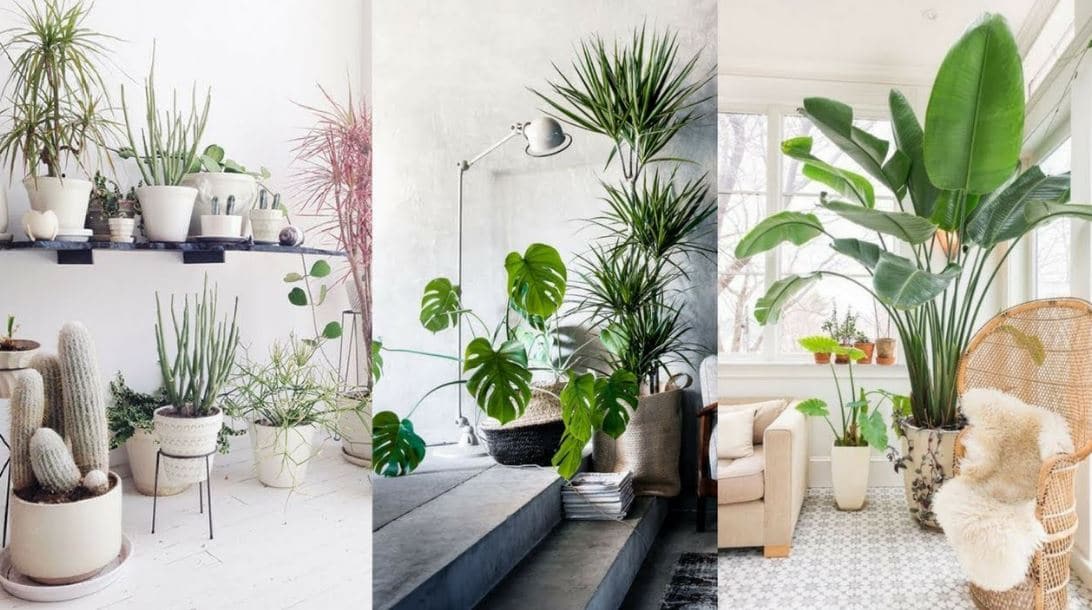
The following is a small list of the indoor plants that are ideal to be placed inside the house and decorate it:
- Potos : They need to be hung and in a space near the light. It is recommended to place them close of the windows.
- Aspidistra : A resistant plant It requires shade and little watering.
- Tronco de Brasil : A plant that It does not need a lot of light and is resistant to drought. Could be placed anywhere in the house.
- Cactus : There are many varieties cactus, but mostly they can be in pots small, they should be watered sparingly, but they need light, so they are ideal to be in the windows.
- Dracena : A plant that does not requires a lot of sun or space. It can measure up to two meters and the way to water it should be moderate.
- Sansevieria : Ideal for places dark, does not require much watering, and can live up to fifteen years with little care.
- Anglaonema : Ideal for interiors, It does not require a lot of light, it must be watered regularly, but it is not cold tolerant.
- Ferns : Ferns are used to hang, they need enough light, so it is recommended that are in the entrance or patio of the house; require watering abundant for its growth and beauty.
- Ficus : A very striking plant and beautiful, which can be used outdoors to decorate or in the indoor as a bonsai.
If we need to increase the repertoire to have more ideas in the interior gardens , we can also consult the Wikipedia list… HERE.
The decorative plants in home are essential to create a relaxed atmosphere, but you have to choose the right ones, especially if you have little time.
Which are the best indoor plants to decorate
There are many plants that adapt well to the home conditions , but among them we can highlight some like the following:

- The sansevieras and cacti in general, due to their little need for irrigation although the former survive better in environments darker than the latter.
- The ficus , the bamboo , the spatiphylls and the dracenas , which need a greater irrigation and environmental humidity.
- The ivy , which is characterized by its rapid growth, sometimes difficult to control, and which is a good option to fill hanging baskets.
- The aromatic plants can be used to decorate any style of kitchen, at the same time that they can become a natural air freshener and be very useful for upcoming recipes.
It is possible to have a small interior garden mixing plants with green leaves with other flowers. So we are going to enumerate the plants most suitable for decoration :
Green plants for decoration interior
- The Brazil Trunk (Dracaena Fragans) Also called the Tree of Happiness, you need to be able to develop that the ambient temperature never drops below 12º C. This species needs to grow in a place well bright but not too sunny so the leaves don't blow burn. You can get to live with less light but in that case its growth will be very slow.
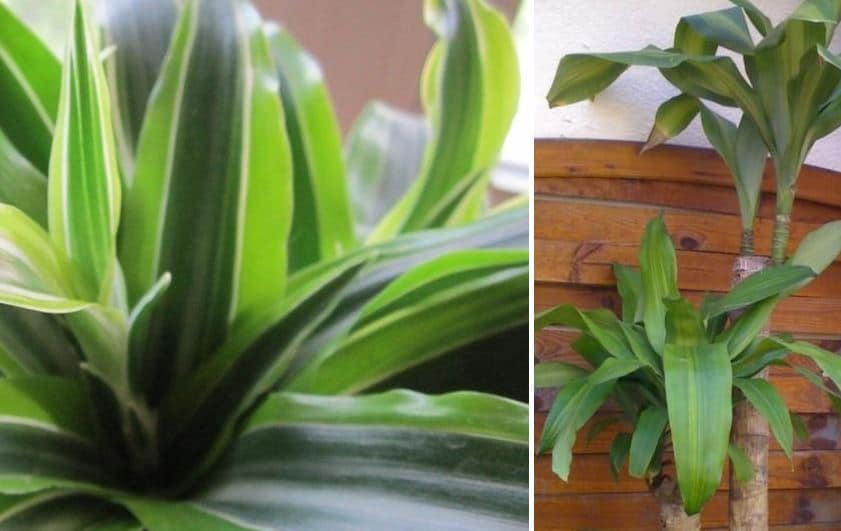
- The Panel Palm (Chamaedorea elegans) is slow growing and rarely exceeds 120 cm tall in pot. In winter it is necessary to ensure that the room temperature does not drop below 10-13ºC, keeping the slightly moist soil. It is very suitable to water this palm tree with rainwater that will prevent chlorosis produced by lack of iron.

- The Ivy (Hedera Helix) was formerly farmed in ways that needed a cool greenhouse, currently we find variegated and dwarf varieties that withstand warm interiors. The little ivies with their leaves tinged with white or gold, can live very well in an apartment counting on a clay soil very well fertilized and with frequent irrigation. The more light the better. In In winter, keep them away from the heating.

They are often used a lot as plants pendants in decoration.
Indoor plants not only have multiple aesthetic benefits, they also provide benefits psychological that make them an unbeatable element for home decoration (See also the coworking office healthier with 1000 plants and the article on how to design a modern garden)
Flowering plants for decoration interior
- The Cymbidea (Cymbidium) is the orchid that provides more flowers to cut with some shades precious. It must be watered abundantly until September and pay it every four weeks with a special fertilizer for orchids. From September and until the end of winter the risks should be more spaced and should not be pay.

- The Saintpaulia or Violet Africana is an indoor plant native to the East Africa and produces permanent flowers similar to violets with a duration of up to three months and with colors ranging from purple to white, passing through pink. Their leaves are velvety and heart-shaped. Needs lots of light but never direct sun. The temperature never less than 12º C.

- Spectacular Amaryllis (Hippeastrum) A from a large bulb you can have a flowering exuberant and very perfumed in the living room at home. blooms Usually between January and April. The Amaryllis needs a very bright place and constant humidity. The water always rain or mineral Once flowering is over, space the watering and stop once the leaves are yellow.

As a help note, NASA wrote a document on the best indoor vegetation with absorption properties and purification of the environment. You can see it from HERE and it is in Castilian.
Tips for decorating with plants
Indoor plants can be grouped together to form small gardens or spread throughout the house or place of work, the important thing is to provide light, irrigation and fertilizer suitable, nature will do the rest and provide the best and most spectacular of the decorations.

The best thing is to find plants that combine with the style of decoration chosen, so that they create a sense of continuity with the rest of the elements decorative.
For example, you can use plants that give more feeling of spaciousness to a small apartment or, for the contrary, that they create a warmer atmosphere in a home of large dimensions.
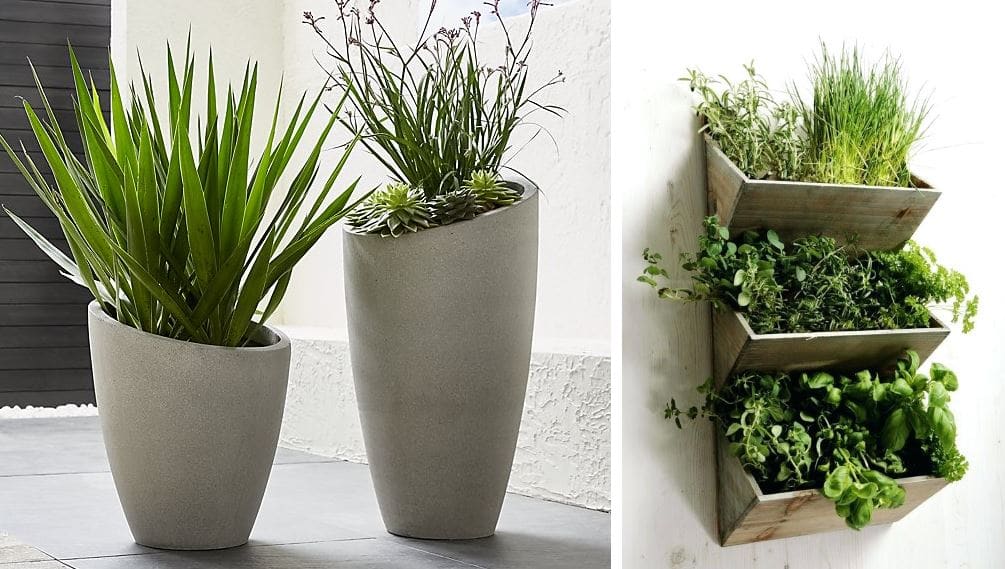
Uniting the plants with decorative pots surprising and low-budget effects can be achieved but plants can also be placed on other types of supports such as hanging baskets or pedestals, depending on the effect you want. we wish to achieve. Any room can be decorated in this way. shape, from the living room to the bathrooms, through the kitchen or the rooms, the combinations are endless.
- Let's choose plants knowing in advance the light and temperature needs.
- We must recognize the space we have and what will be the growth of the plant (Remember that the radiators and currents influence negatively).
- An outdoor plant can never survive in the interior of a house.
- Always choose a good planter that you will also have in the market with excellent designs and colors. (not worth the shame to have a beautiful plant in a pot horrendous)
The flowerpots and ceramic pots in classic decoration , they always combine ok.
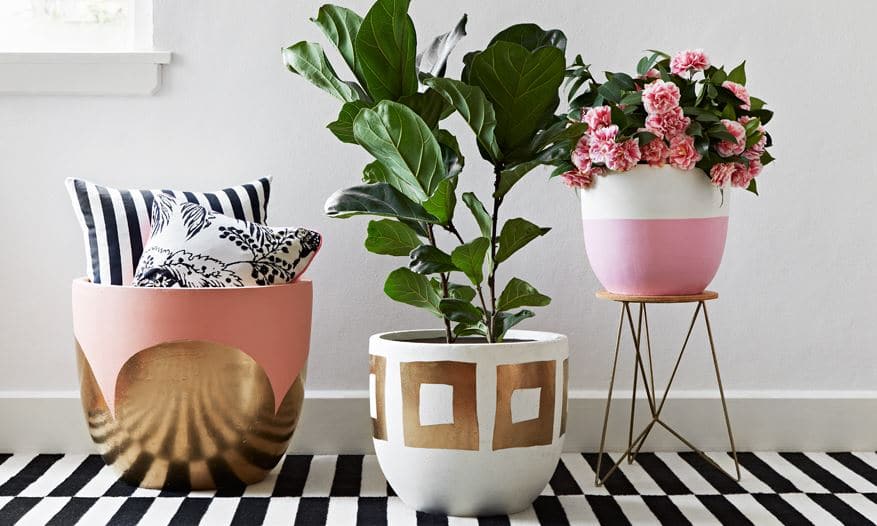
The flowerpots and wooden pots in decoration rustic blends seamlessly (You can even place wicker baskets).

The flower pots and concrete, glass or designer ceramics combine perfectly in a modern decoration . (As a curiosity, we can read the article about Kokedama, the Japanese alternative to decorate your house with potted plants… HERE)
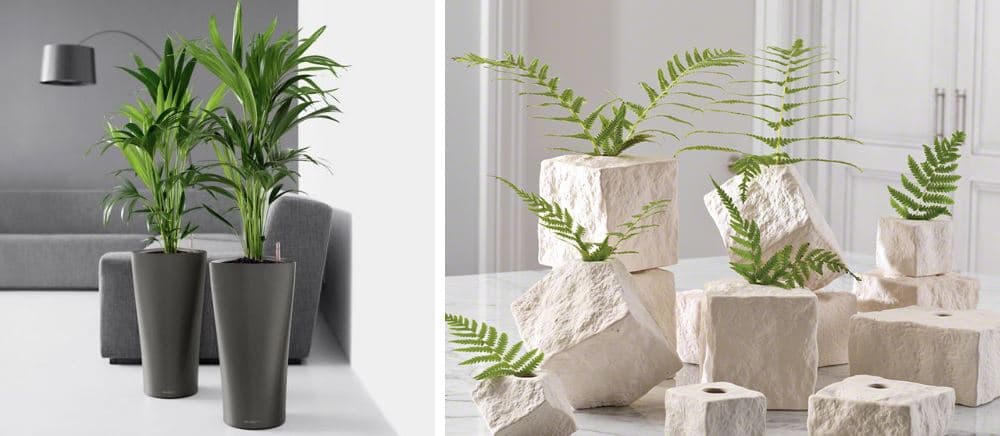
- It is suitable for any style of decoration use pots in groups of two or three, whether equal or of different sizes.
- The plants are an excellent delimiter of de zones ; To mark the dining room or living room area, a office in the dining room, or starting a ladder.
- They create focal points. A nice plant and Appropriate dimensions will always attract attention.
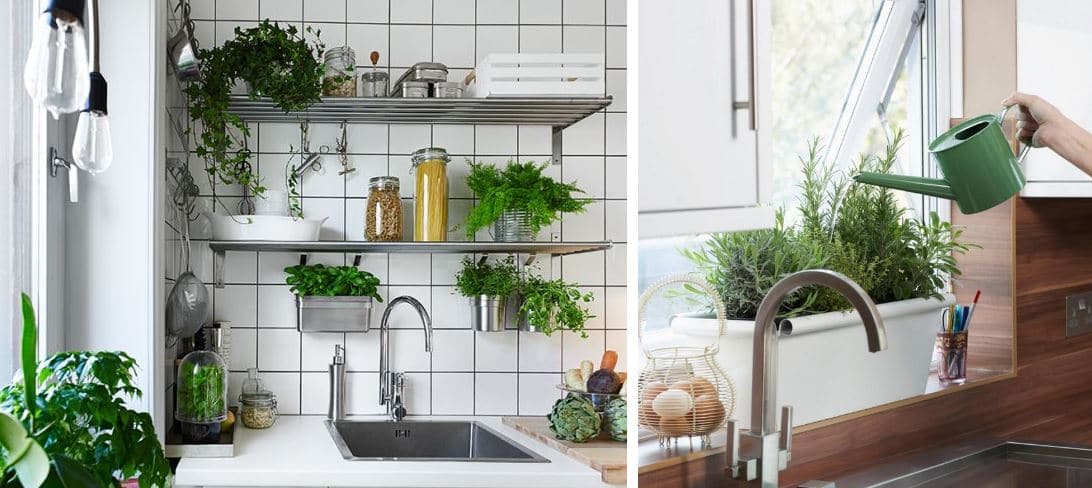
- In the kitchen, plants are used aromatic that also, some types, we can use for cooking.
- Recommended plants with personality to place them in centerpieces, in a bathroom without abusing or in the kitchen.
- They are excellent for high ceilings. The example perfect is the bamboo that has stems that can reach a considerable height. Also the Hydra or its variants that we can encourage them to climb the walls.
Many times we stop having plants in the housing for not having time for their care, which causes many to dry out due to lack of watering or all contrary, that they drown due to an excess of water, but there are beautiful plants that grow without problems and survive our lack of care.

As a note: we can also create a green blanket or wall on the wall and get out of the traditional. We can see an article extensive guide on how to create a vertical garden at home.
Which indoor plants are more resistant and easy to grow
Although we have to comment that in reality the list can be very long, in a generalized way, the plants of resistant interiors and that do not need too much attention would be:
- Cissus : scientific name Cissus rhombifolia. Originally from South Africa, it is a hanging plant. of beautiful dark green leaves that lives perfectly in dimly lit places. Regular watering in summer with fertilizer liquid every fortnight and little watering in winter.
- Ivy : scientific name Hedera helix. Native to Europe and Africa, ivy is one of the most grateful plants that exist. Live without problems with little light and regular watering. Can be used as a plant pendant or put some tutors to go entangling the long branches. The best varieties to give color to the house are the dwarfs with variegated leaves.
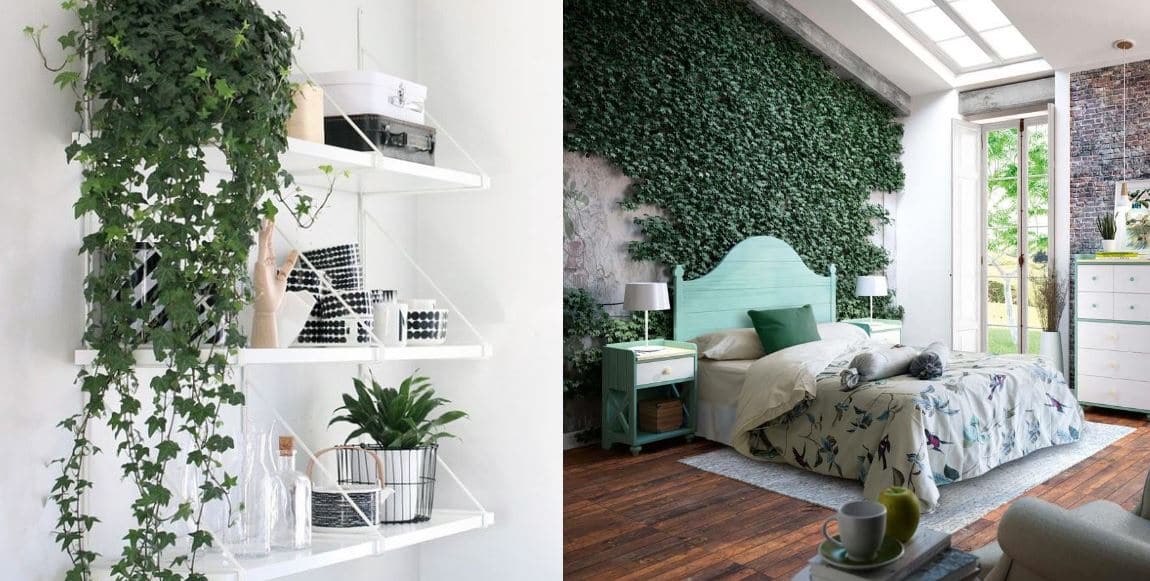
- Singonium : scientific name Syngonium podophyllum. Originally from Africa, its leaves in arrow-shaped in a green tinged with cream, they are very attractive. It is not demanding regarding light or risks. With very little care you get a beautiful and bushy plant that can live many years, transplanting it from time to time when.
- Tradescantia : scientific name Tradescantia fluminensis. Originally from South America, the tradescantia, with its small and abundant glossy leaves metallic and purple underside, it is a stupendous upholstery plant suitable to brighten up any corner of the home; especially bathrooms and kitchens, since the environmental humidity favors its growth.
- Aspidistra : scientific name Aspidistra elatior. Originally from China and Japan, it is a plant robust, with long glossy dark green leaves, in marbled occasions in cream. also popularly called "tin", this plant resists everything, low light and watering scattered although it appreciates a good fertilizer during the summer.

- Sanseviera : scientific name Sansevieria. The so-called "Mother-in-law's tongue" is a plant rhizomatous native to Asia and Africa. very popular makes some years, although currently it has been relegated, giving prominence to other more exotic plants; No However, the sanseviera has long and fleshy leaves that they mix dark green and cream in their coloration being very decorative. Endure the lack or excess of light and irrigation without problems. Ideal for the hall or highlight any corner.
Despite having little time, it is always possible to decorate the house with beautiful and resistant plants that cheer us up the view upon returning from a day of hard work, it is only necessary to choose the variety that best suits our circumstances and we can enjoy a relaxing contact with the plant world in the middle of the urban jungle.
How to take care of plants interior
Place in corridors, stairs, balconies, near the windows or even in the bathroom, plants brighten up the rooms at home.
When it is decided to include plants in the decoration of the house , the most important thing is to find out about your basic needs: adequate amount of light and temperature, at so that the home can be conditioned as close to your natural environment. There are a number of recommendations that they must continue to achieve it.

What is the ideal temperature for plants?
In each room the temperature is different; must be measure it so that the plants flourish. In order to determine the appropriate weather, it is advisable to follow the following table:
- Low (cool environment) ; the minimum temperature is 7 to 10 °C, it is what the outdoor plants that are sometimes kept indoors for example: azalea, heather, spring, cyclamen, etc. It is also recommended for some more typical species of interior, such as aucuba, aralia or ivy.
- Moderate (temperate environment) ; the minimum temperature is around 20 to 15 °C and is ideal for plants such as clivia, aspidistra, asparagus or cheflera
- High (warm environment) ; the minimum temperature ranges between 15 and 20 °C, it is ideal for most indoor plants such as: dracaenas, bromeliads, orchids, ficus, etc.
Note: to determine the temperature in the rooms, use an environmental thermometer, you can get it in stores specialized in gardening.

How much light do plants need? plants?
Light is the source of plant life, because through They carry out the process called photosynthesis, by which they survive.
Plants are divided into three large groups according to the need for light:
- Those that need direct sun (avoid noon).
- Those that require a more or less intense light, but without direct exposure to the Sun.
- Those that grow in the shade.
Therefore, you must know which plants to choose and where place them, all according to the light they need.
Almost all houseplants prefer sites in the house where they have enough lighting, but without sunlight directly on them. So you must ask if the plants They are affected by the sun's rays or not. If this happens, put curtains or blinds on the windows.
To give more light to the spaces of the house, paint with light colors, such as beige or white, and placing mirrors and glass objects. Of interest the article on architecture of natural light where we explain more concepts.
Most plants with colored leaves need intense lighting to maintain its color, even without sun direct.
Plants with decorative flowers should be placed in well-lit places; if not, there is a risk that flourish.
Can artificial light be used in plants?
It is not necessary to have a house or house with very good lighting, artificial light can be used so that the plants flourish:

- Place lamps above the plants so that they provide the necessary light.
- If lit with light bulbs, they will have little light, but quite warm. That is why the plant must be very attached to the focus. Fluorescent tubes only illuminate more intense than incandescent light bulbs.
- If you combine the light from fluorescent tubes and that of traditional bulbs, a light will be obtained identical to solar.
Of interest for your curiosity the article on plants that give light and another article on nanotechnology in plants to provide own light from HERE.
How to know if there is a lack of light in the plants?
It is true that some plants need less light than others, but its scarcity can cause a pale and weak appearance, few or no flowers, falling leaves and a weakness that such time lead them to death.
Check the light that some plants require:
- Intense light on a plant : altea, aralia, ardisia, coleus, croton, clivia, croto and bromeliads.
- Average light on a plant : aphelandra, azalea, cheflera, cyclamen, dracaena, marginata, brazilwood, yucca and ficus
- Low light on a plant : aglaonema, alocasia. flower begonia, caladium, cissus, philodendron, fern kentia, peperomia, sanseviera and syngonium.

How much humidity do plants need? inside?
Each plant requires different amounts of water each day. In order not to overdo it, ask before buying it, but if you wants to check if the plant is well watered, check it from the following form:
- Direct verification: insert the finger a couple of centimeters on the ground. If the earth does not remain adhered nor traces of moisture appear, it means that it must be water.
- Lift the pot. If you feel light, you lack water.
- If the soil appears lighter in color than normal and the plant detaches easily, it is necessary to hydrate it as follows: immersing it up to the root neck in a deep container with water, leave it inside until the bubbles disappear. air.
When should I avoid watering the plants?
- When the wind blows.
- In full sun or during hot hours.
- With ice cold water. Use lukewarm water, the reason is that the cold water decreases the absorption of nutrients
- No order (Sprinkle evenly throughout the pot).

Pests and diseases of plants
In order not to allow the plants to get sick, there are to act first:
- Check the suitability of the exposure. That is to say Sometimes the excess of Sun or the opposite causes the bad aspect. They must find another space or cover them.
- Make sure the fertilizer is adequate, if you lose its green leaves, it may be due to an excessive amount of pass. Remove the pot from the plant, remove the roots dead, remove most of the soil and place it on the pot.
- Take care that diseased plants are not left next to healthy ones because pests can spread and diseases.
- Check buds and veins regularly of the leaves, as they are favorite places for pests such as aphids.
What are the benefits of having plants in home
The plants will bring us a touch of color and joy to our home, house or office, they also provide other benefits with reference to health and that have been more than tested:
The previous photograph is from the article green architecture where we enter one of the buildings with the largest number of trees in the world.
- They reduce stress, since they help the atmosphere calms down. They attract the good energies.
- In the case of offices, it has been shown that having plants helps to improve the efficiency of workers, apart from harmonizing the work environment.
- They help reduce dust, both in houses as in offices, up to 20% of the amount usual.
- They reduce the levels of dioxide and nitrogen, which are harmful gases and can affect the health of beings humans.
In addition, in the following tool you can see the twelve that purify the air the most according to NASA.
Also of interest is the article on tips for creating houses more comfortable.
Tips to maintain the plants of interior
We want to provide a series of advice for the indoor plant care for house shape general and that we should not forget:

- Pruning off those leaves that are withered will help make the plants much more radiant.
- Establish a single place to place them, preferably the living room, and not change their place much anymore that this does not please the plants, and they can be wither.
- Avoid placing plants on tables by the constant movement to which they are exposed and because they they might fall.
- Choose planters that do not hold too much moisture because it could backfire and kill the plant.
- Avoid having plants in bedrooms and choose more showy and spacious places so that they can give all the necessary energy.
- Avoid having plants near the kitchen or very hot places because they will not resist and, therefore, they will die.
- Plants are also living beings and it is the duty It is up to their owners to take care of them and keep them beautiful.
For oxygen to flow in the home there is nothing better than grow plants. If you do not have a garden, it is not a reason to concern, as we have seen, there are species that can adapt to all corners of the interior of the house or housing.






















